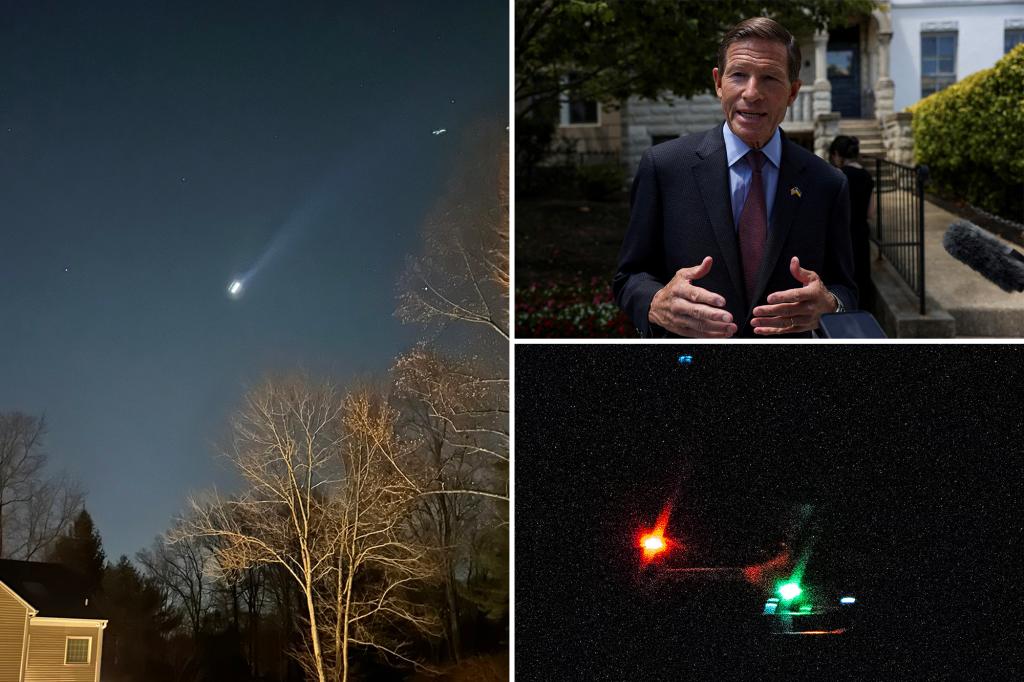The recent surge in reported drone sightings across the mid-Atlantic region, particularly over New Jersey and Connecticut, has sparked concern and calls for a more aggressive response from the US government. Senator Richard Blumenthal of Connecticut has voiced his apprehension, urging for intelligence analysis and, if necessary, the downing of these unidentified aircraft, especially those hovering near sensitive areas like airports and military bases. He underscores the “absolutely unacceptable” lack of information regarding the drones’ origin and ownership, fueling fear and anxiety among his constituents who are worried about potential surveillance and the safety of air travel. This anxiety stems from the unknown nature of these drones and their potential purposes, ranging from harmless hobbyist flights to malicious surveillance or even sabotage. Blumenthal’s strong stance reflects a growing unease about the security implications of these unexplained aerial activities.
While Senator Blumenthal advocates for a proactive approach, the White House maintains a more cautious stance. National security communications advisor John Kirby asserts that many of the reported sightings are likely misidentified, lawfully operated manned aircraft, dismissing the immediate threat to national security or public safety. He emphasizes the ongoing investigation led by the Department of Homeland Security and the FBI, in collaboration with state and local law enforcement, utilizing various detection methods to determine the drones’ origins. This investigation, according to Kirby, has not yet uncovered any evidence of malicious intent, criminal activity, or foreign involvement. This measured response suggests a commitment to thorough investigation before escalating actions against the perceived threat. The contrasting viewpoints underscore the complex challenge of balancing public safety concerns with the need for evidence-based action.
The apparent disconnect between the Senator’s urgent appeal and the White House’s composed response highlights the information gap surrounding these drone sightings. While Senator Blumenthal emphasizes the public’s fear and the potential security risks, the White House prioritizes a systematic investigation to ascertain the nature of these drones and the validity of the reported sightings. This difference in approach likely stems from access to classified information and ongoing investigative efforts that may not be publicly available. However, the public’s concern remains palpable, emphasizing the need for transparent communication and timely updates from the authorities to address the growing anxiety. This underscores the delicate balance between maintaining security protocols and assuring the public amidst uncertainty.
Adding another layer of complexity to this issue is Senator Blumenthal’s warning against the use of Chinese-manufactured drones. He highlights their potential as “sources of surveillance data” and “security threats,” urging Americans to opt for domestically produced drones instead. This warning taps into broader national security concerns regarding Chinese technology and its potential for espionage or data breaches. It raises questions about the security protocols surrounding commercially available drones and the potential vulnerabilities they could present, particularly in the hands of malicious actors. This concern adds weight to the argument for stricter regulations and oversight of drone usage, especially in sensitive areas, to mitigate potential security risks.
The drone sightings, regardless of their ultimate explanation, have unveiled a significant gap in the existing regulatory framework governing drone usage and the ability to effectively identify and track them. The current ambiguity surrounding these sightings highlights the need for more sophisticated detection technologies and robust response protocols to address potential threats swiftly and effectively. The ongoing investigation underscores the importance of collaboration between federal, state, and local agencies in managing these incidents and developing comprehensive strategies for future drone-related events. This collaborative approach is crucial to ensuring a unified and effective response to potential security threats posed by unidentified aerial activities.
The ongoing debate surrounding the unidentified drones serves as a catalyst for a broader conversation about drone security and the need for a comprehensive regulatory framework. Balancing the legitimate use of drones for various purposes with the imperative to protect national security and public safety requires a multifaceted approach. This includes strengthening regulations, investing in advanced detection technologies, and fostering international cooperation to address the evolving challenges posed by the increasing prevalence of drones in our airspace. The current situation emphasizes the urgency of this discussion and the need for proactive measures to safeguard against potential threats while promoting responsible drone usage. Only through a comprehensive and collaborative approach can we effectively address the complex security and privacy concerns surrounding this rapidly evolving technology.










